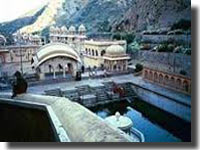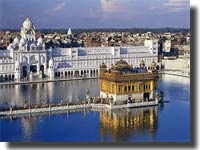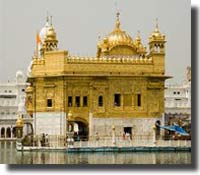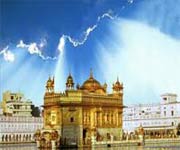Location :
This style of Gurdwara has been developed in the Dravida Desam. The Vimana and the Gopurams are the usually the distinctive characteristics of the Southern style. The Vimana is a tall pyramidal tower which consists of several progressively smaller storeys and it stands on a square base. The Gopuram has two storeys seperated by a horizontal moulding. The Prakara or the outer wall envelops the main shrine as well as the other smaller shrines, the tank.
Sri Harmandir Sahib is also named as Sri Darbar Sahib or Golden Temple, due to account of its scenic beauty and golden coating for English speaking world, it is named after Hari(God) the temple of God. The Sikhs all over the world, wish to pay a visit to Sri Amritsar and to pay obeisance at Sri Harmandir Sahib in their Ardas which are their daily prayers.
History of the Temple

Guru Arjan Sahib got its foundation laid by a muslim saint Hazrat Mian Mir ji of Lahore on 1st of Magh, 1644, Bikrmi Samvat (December,1588). The construction work was directly supervised by Guru Arjan Sahib himself and he was assisted by the prominent Sikh personalities like Baba Budha ji, Bhai Gurdas ji, Bhai Sahlo ji and many other devoted Sikhs.
Unlike erecting the structure on the higher level(a tradition in Hindu Temple architecture), Guru Arjan Sahib got it built on the lower level and unlike Hindu Temples having only one gate for the entrance and exit, Guru Sahib got it open from four sides. Thus he created a symbol of new faith, Sikhism. Guru Sahib made it accessible to every person without any distinction of caste, creed, sex and religion.
Architecture of the Golden Temple
Sri Harmandir Sahib Gurdwara is built on a 67ft. square platform in the centre of the Sarovar. The Gurdwara itself is 40.5ft. Square and has a door each on the East, West, North and South. The Darshani Deori is an arch that stands at the shore end of the causeway. The door frame of the arch is about 10ft in height and 8ft 6inches in breadth. The door panes of the Gurdwara are decorated with artistic style. It opens on to the causeway or bridge that leads to the main building of Sri Harmandir Sahib.

The main structure of Sri Harmandir Sahib Gurdwara, functionally as well as technically is a three-storyed one. The front one which faces the bridge, is decorated with repeated cusped arches and the roof of the first floor is at a height of 26 feet and 9 inches.
At the top of the first floor there is a 4 feet high parapet rising on all the sides which has also four 'Mamtees' on the four corners and exactly on the top of the central hall of the main sanctuary rises the third storey. It is a small square room which has three gates. A regular recitation of Guru Granth Sahib is also done there. On the top of this room stands the low fluted 'Gumbaz' a dome having lotus petal motif in relief at the base inverted lotus at the top which supports the 'Kalash' having a beautiful 'Chhatri' at the end.
The architecture of the Mandir represents a unique harmony between the Muslims and the Hindus way of construction work and this is considered the best architectural specimens of the world. It has been a school of architecture in the history of arts in India.
Significance of the temple
The Golden Temple popularly known as Sri Harmandir Sahib was founded by the Sikh guru, Guru Ramdas and was ultimately completed by Guru Arjan Dev. This wonderful temple is built exactly in the middle of square tanks and there is water all around. The gold covered exterior of the Gurdwara looks amazingly beautiful. Sikh people from various regions of the world come and pay a visit to this holy place every year in lots of numbers. There is a rich history associated with it and the significance of Golden Temple is also very much tremendous.
It has always been the Sikh people's rallying point throughout its history. The first edition of the "Guru Granth Sahib" in the year 1604, which is regarded as the most holy book of Sikhism and even the holiest literature of this religion, was installed here. Baba Buddha was the first caretaker of the book or the first 'granthi'. In the year 1699, Guru Gobind Singh, tenth guru of Sikhs laid the establishment of 'Khalsa Panth'.

The Baisakhi celebrations are organized here very grandly, which is attended by thousands of people around the world.
The holy tank of the Gurdwara is considered as very holy and the Sikh people try to pay a visit to this temple and for taking a holy bath at the tanks of the temple. It has been believed that a single bath at this holy water will properly cleanse the soul. This holy tank of Harmandir Sahib was built by Guru Arjan Dev.
People here from different sections of the society irrespective of caste, gender, race and religions come and worship the almighty. Golden Temple has been the symbol of peace, magnificence and strength. It is actually the main pilgrimage and spiritual center for the Sikh people throughout the world.
Time to Visit
Best Time to visit Amritsar Golden Temple is between the months of October and March. Even at the time of festivals many people visit Amritsar. Majority of festivals celebrated in Amritsar are religious in nature like during the Basanth Panchami, Baisakhi & Gurupurabs.
Other Places to Visit
AKAL TAKHAT - It rightly faces the Golden Temple. Built by the Sixth Master Guru Hargobind (1606-44) in 1609, it has been the nerve centre of the Sikhism ever since.
BABA ATAL - A nine-storeyed tower, built in memory of Atal Rai (D. 1628), a son of Hargobind, is called Baba Atal. Atal Rai died at nine. He was called 'Baba' (an old man) head over young shulders.
GURU KA LANGAR - A Sikh temple without a Community Kitchen would be inconceivable. Cooked food is served in the kitchen of the Golden Temple 24 hours to all visitors irrespective of religion, caste, creed and nationality. The expenses are met out of the Temple funds. Approximately 40,000 visitors share the meals in the Gurdwara everyday presently.
There are even historical landmarks like Jallianwala Bagh, Ram Bagh, etc.
Accommodation Facilities at the Temple
Hotels in Amritsar offer a comfortable stay for business and leisure travelers as well as devotees. All the Hotels are situated in the heart of the city.
| Shri Guru Ram Das Niwas is a place for accommodation of the visitors with about 228 rooms and 18 big halls constructed by the Gurudwara Committee. The facilities of bedding, fans, cots are provided free of cost. The visitors are not allowed to stay for more than three days.
Guru Nanak Niwas has 66 rooms including 22 rooms with baths. |
Nearby tourist places to Golden Temple Chamba Chandigarh Dalhousie |
 |
How to reach the Temple
- The airport at Amritsar for reaching Golden Temple is named Raja Sani International Airport which offers excellent services. The airport here is well connected to other parts of the country by regular flights. Today Jet Airways, Turkmenistan, Uzbekistan and Air India also offer flights to Amritsar from Delhi, Birmingham and London.
- The Railways are also well established in Amritsar.. It takes about 8 to 10 hours to reach Amritsar by train from Delhi.
- By Road one can reach Amritsar through Grand Trunk Karnal Road which connects Delhi to Amritsar. Regular buses are available from I.S.B.T. Delhi to Amritsar. One can choose from local, semi deluxe, deluxe and super deluxe buses offered by the bus station.



